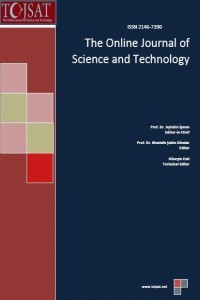From Minimum Tillage to No Tillage, Reaction of Waha, Variety of Durum Wheat in Algerian Semi-arid Region
From Minimum Tillage to No Tillage, Reaction of Waha, Variety of Durum Wheat in Algerian Semi-arid Region
crop management, direct drilling, conventional tillage minimum tillage, stomatal resistance, RWC, variety WAHA,
___
- Arabi, M. and Roose, E. 1989. Influence de quatre systèmes de production en région méditerranéenne de moyenne montagne algérienne. Bull. Réseau Erosion, ORSTOM, Montpellier 9: 39-51
- Barrs, H.D. and Weatherley, P.E. (1962). A re-examination of the relative turgidity technique for estimating water deficits in leaves. Aust. J. Biol. Sci., 24: 519-570.
- Belaid, D. 1987. Etude de la fertilisation azotée et phosphaté d'une variété de blé dur (Hedba3) en condition de déficit hydrique . Thèse magistère INA, 180p.
- Belgueri, H., Bellameche, F., and Habittouche, F. 2007. Contribution à l'étude de l'effet du semis direct en zone semis aride de Sétif. mémoire d'ingénieur univ. Msila .80p.
- Chartzoulakis, K., Patakas, A. and Bosabalidis, A.M. 1999. Changes in water relations, photosynthesis and leaf anatomy induced by intermittent drought in two olive cultivars. Couvreur, F. 1981. La culture de blé se raisonne. Cultivar, Vol. 170 ; pp : 39-41
- Denden, M. and Leumeur, R. 2000. Modélisation de la résistance stomatique en fonction des caractéristiques morphologiques et anatomiques des stomates, du rayonnement et du potentiel hydrique. Sécheresse 2000, Vol. 11 N°1, pp. 29-36.
- Ghouar, W. 2006. Effet du cumul de pluie hivernale sur la réponse du cultivar Waha (triticum durum desf) à la fertilisation azotée. Mémoire magistère .université de Batna. 66pp.
- Kasraoui, M. F. ; Attia, F. ; Denden, M. ; Braham, M. ; Mehri, H. ; Lamaze, T. et Garcia, M. 2004 «Photosynthesis, chlorophyll fluorescence and water relations in olive tree (Olea europeae L.) CVS Chemlali and Chetoui during water stress» In Premier Séminaire International sur les Biotechnologies et Qualité des Produits de l’Olivier dans le Bassin Méditerranéen (Olivbioteq 2004) Errachidia (Maroc) 22 – 24 Novembre 2004.
- Kribaa, M. 1992. Contribution à L’étude de L’irrigation d’appoint et de La fertilisation azotée du blé dur (Waha) en zones semi-arides cas des hautes plaines Sétifiennes. Thèse Magister. INA, Alger, 85p.
- Onyibe, J.E. 2004. Effect Of Irrigation regime On Wheat (Triticum Aestivum L.) Growth And Yield In Semi-Arid Tropics. Agronomie africaine. Vol. 1 (1) pp. 45-58
- Oukarroum, A. 2007. Vitalité des plantes d’orge (Hordeum vulgare L.) en conditions de stress hydrique et thermique analysée par la fluorescence chlorophyllienne. Mémoires Doctorat. Université de Genève. 195pp
- Thomas, F., Archambeaud, M., Billerot, S. and De Carville, C. 2005. Technique de conservation du sol. Édition Sulky Burel, edit.2005 .pp88
- ISSN: 2146-7390
- Başlangıç: 2011
- Yayıncı: The association of science, education and technology
Semantic Adaptation Approach for Adaptive Web-Based Systems
Bujar Raufi, Artan Luma, Xhemal Zenuni, Florije Ismaili
Laboratory Stands for Wideband Analysis Radiocommunication Signals
Ryszard Studanski, Radosław Was, Agnieszka Studanska, Jarosław Garus
The Effect of Hypergravity on the Germination and Growth of Eruca Sativa Mill
MARLISE ARAUJO DOS SANTOS, THAIS RUSSOMANO, FLAVIA NATHIELY SILVEIRA FACHEL, EDUARDO CASSEL, LEANDRO VIEIRA ASTARITA
The effect of monks in the Hungarian Urban Design and Landscape Forming
Benkherbache N. Benniou R., Merat M., Mekhalfia T., Makhlouf M.
The Shell Characteristics of Land Snail Eobania Vermiculata (Müller, 1774) From Croatia
Biljana Rađa, Tonći Rađa, Mate ŠAntić
Virtualmatriks: A Conceptual Mathematization Process in Virtual Learning Environment
Character Level Authorship Attribution for Turkish Text Documents
Municipal Solid Wastes Gasification/Polymer Electrolyte Membrane Fuel Cell Integrated CHP System
Ademola Rabiu, Ismail Adefeso, Daniel Ikhu-Omoregbe
Myco and Phyto Remediation of Heavy Metals from Aqueous Solution
